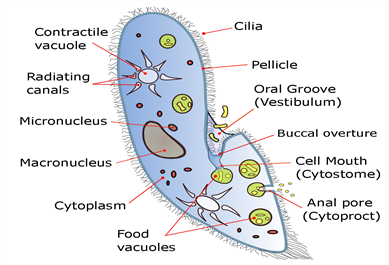PDF chapter test TRY NOW
Protozoa are unicellular eukaryote organisms and belong to the kingdom 'Protista'.
There are about 70 thousand species Protozoa.
- Their body consists of one cell, which performs all the vital functions inherent in the whole organism: movement, nutrition, respiration, excretion, etc.
- The shape and size of the protozoan cells are diverse. The size of the cell may vary between 2 and 200 microns. You can see them only with the help of magnifying devices. There are also colonial forms of protozoa. Some protozoa do not have a constant body shape (Amoeba); in others, it is relatively constant (Paramecium).
- Protozoa are present in moist places like ponds, rivers and oceans. They are also found in the animal and human bodies.
- Protozoa live mainly in a liquid medium (in sea and freshwater ponds, moist soil). Under unfavourable conditions such as drying out of reservoirs or raising and lowering of temperatures, protozoa form a dense protective shell, turning into a cyst.
Protozoa structure
The following are some of the important body parts and their functions in protozoa.
Body parts | Functions |
| Pseudopods (pseudopodia) | Help in movement and capture food |
| Cilia | provide faster movement |
| Flagella | provide faster movement |
| Digestive vacuoles | To capture the food particles |
| Contractile vacuoles | Removes excessive water and harmful chemicals and provide stability to the cell. Also removes digested materials. |
Cell structure of Amoeba

- Amoeba does not have a regular structure, it has an irregular shape. It is an unicellular organism. It has a well defined nucleus and other cell organelles. All these are within a cell membrane.
- Amoeba moves using pseudopodia, roughly translated as 'false feet' from Latin.
- Pseudopodia not only help Amoeba to move around but also help in catching its prey or food. These pseudopodia encircle the food particles and join together to form a vacuole called food vacuoles/ digestive vacuoles.
- Another type of vacuoles are found in the cytoplasm, known as contractile vacuoles, which help in the removes of excessive water inside the amoeba cell and thus provides stability to Amoeba. These contractile vacuoles also act as a means to remove the digested materials from the cell.
- Amoeba splits into two and starts living as two separate entities or cells. This is called 'fission'. Amoeba also reproduce by means of sporulation.
Types of protozoa
The following are the major types of protozoa.
- Ciliates are the type of protozoa which uses cilia for their movement. Paramecium is a ciliate.
- If a protozoa uses flagella for its movement, then they are called flagellates. Euglena is a flagellate.
- When protozoa use pseudopodia for its movement, then they are called as pseudopods. Amoeba is a pseudopod.
- Sporozoans are a special type of protozoa found as parasites in human and animal bodies. Plasmodium is a sporozoan.

Important!
Do you know:
What is the study of protozoa called?
Protozoology!
Reference:
Image credit:
Amoeba: Free image from Wikipedia; https://upload.wikimedia.org/wikipedia/commons/9/9c/Amoeba_%28PSF%29.svg
Paramecium: Free image from Wikipedia; https://en.wikipedia.org/wiki/Paramecium#/media/File:Paramecium_diagram.png
